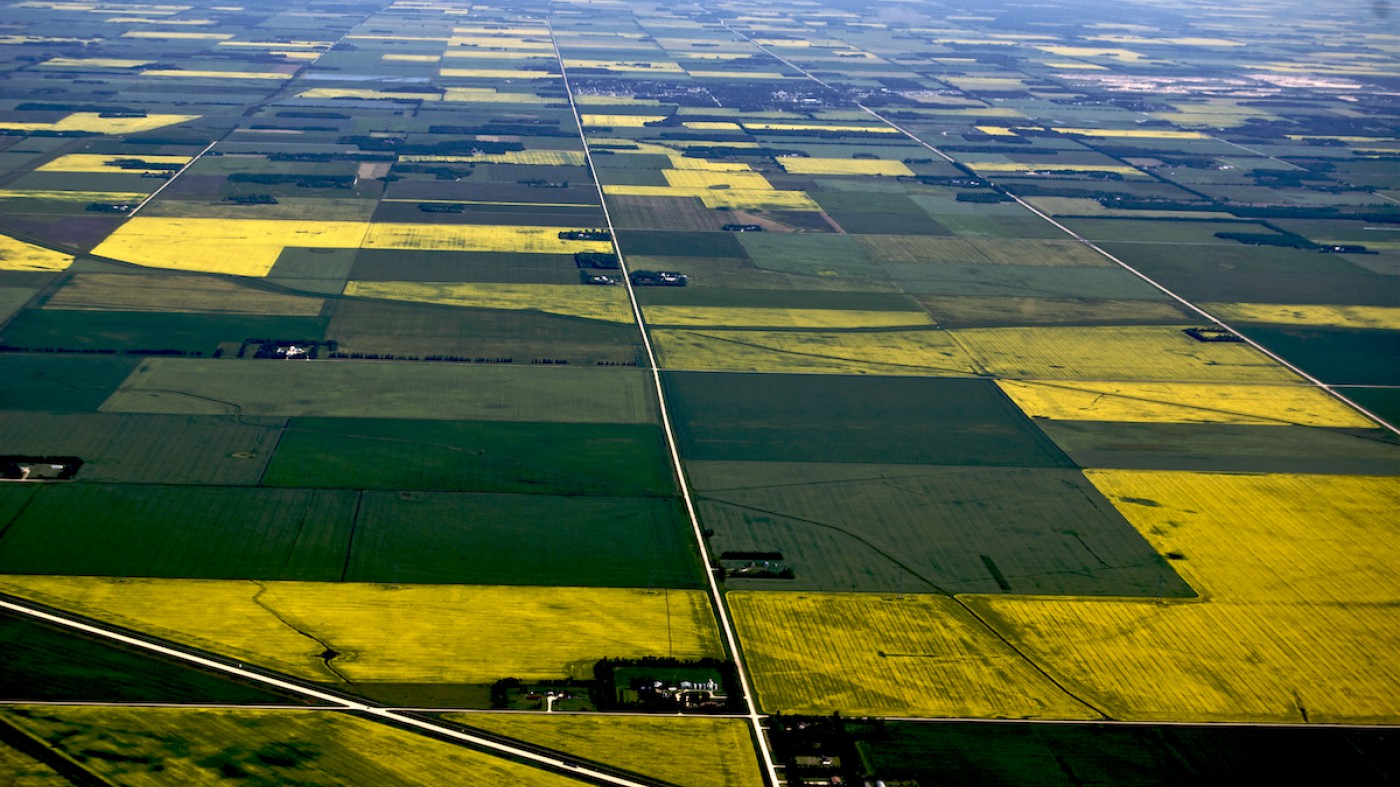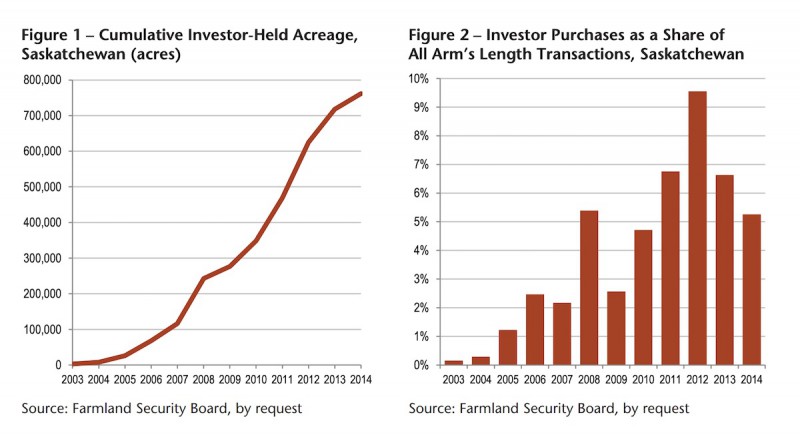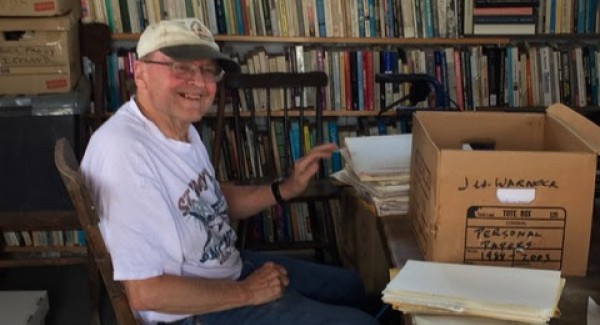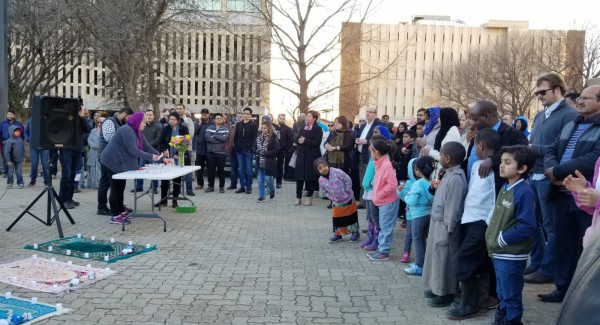Selling off Saskatchewan

Farmland in Saskatchewan. Joel Penner/Flickr.
Golden-hued grasses swaying in the wind on endless stretches of flat prairie – it’s usually the first image that comes to mind when you think of Saskatchewan. These grasslands offer more than just scenery; they store copious amounts of carbon in their roots and soil and are critical for the survival of local biodiversity. They also form the basis of Plains Indigenous Peoples’ cultures, providing food, medicines, and space for ceremony. Yet over the last decade, these grasslands have been dwindling fast, as publicly held Crown lands are sold into private hands and cleared to make way for farms. Over one million acres of grasslands have already been sold to date, and the government seems intent on selling more while disregarding the detrimental impacts of doing so.
In March, a coalition of over 20 agricultural, environmental, and Indigenous organizations called on the Government of Saskatchewan to put an end to the sale of Crown land in the province. If privatization of the land continues unchecked, they say, it will have disastrous effects on the native prairie and its biodiversity, as well as on the exercise of Treaty and Aboriginal Rights.
A history of Crown land privatization
Trevor Herriot, a prairie naturalist and member of the group Public Pastures – Public Interest, refers to the privatization of Crown land as a “hidden tragedy,” one that people in Saskatchewan are largely unaware of. But why is selling Crown land such a contentious issue? To understand, let’s back up a little.
When European settlers arrived on the Prairies during the late 18th and early 19th centuries, they quickly began to drain and cultivate ecologically rich lands using European farming practices. Those unsustainable practices led to intense droughts during the 1930s, causing widespread damage to farmlands and forcing many farmers to abandon their farms. The federal government was faced with a choice: restore the land or risk it becoming a desert unsuited for growing anything. It chose the former, and the Prairie Farm Rehabilitation Administration (PFRA) was created in 1935, with its new headquarters in Regina. The PFRA launched emergency programs to manage soil erosion and water scarcity: it introduced strip farming (growing different crops in alternating strips), dug water reservoirs on farms, planted trees to stop wind erosion, and built large-scale irrigation projects. It also supported local farmers and ranchers by managing community pastures and facilitating cattle grazing.
Trevor Herriot, a prairie naturalist and member of the group Public Pastures – Public Interest, refers to the privatization of Crown land as a “hidden tragedy,” one that people in Saskatchewan are largely unaware of.
In 1939, Manitoba and Saskatchewan launched the Community Pasture Program (CPP), through which parcels of damaged, abandoned land and native rangelands were identified and transferred to the federal government for rehabilitation and management. After only one year, around 700,000 acres of abandoned land had been transformed into flourishing rangelands. But in 2013, Stephen Harper’s Conservatives decided to dissolve the PFRA Community Pasture Program, and responsibility for community pastures was passed back to the provinces – leaving the fate of 1.8 million acres of Saskatchewan grassland in jeopardy.
At the time, the Government of Saskatchewan was set on selling the freed-up land, but opposition from farmers, ranchers, conservationists, and Indigenous people tipped the government’s decision in favour of leasing the land through 15-year-long agreements. Until 2006, the provincial government was managing 7.3 million acres of land either through community pastures or by leasing it to farmers and ranchers. When the Sask Party came into power in 2007, the government escalated its efforts to sell off the Crown land. Approximately 500,000 acres of Crown land were sold between 2008 and 2014 under the Agricultural Crown Land Sale Program, and in 2015 another incentive program was introduced to offer a 15 per cent discount to leaseholders. According to Public Pastures – Public Interest’s estimate, the government has earned $458 million in revenue by selling somewhere between 1 and 1.5 million acres of land.
In 2014, the provincial government found a loophole that allowed them to sell even more land. This time the government came for the areas designated under the Wildlife Habitat Protection Act (WHPA), which allowed certain activities like grazing and haying on the land but strictly prohibited clearing, draining, and sale to private entities. The government proposed an amendment to the WHPA: they would assess all the protected Crown land in the southern part of the province and rank it on its “ecological value.” A computer model, the Crown Land Ecological Assessment Tool (CLEAT) was used to assess land based on factors such as natural cover, unique ecological features, and species at risk – even though when the CLEAT was developed, less than 1 per cent of all the land parcels to be evaluated had been physically inspected. The government concluded that 525,000 acres of land had “lower ecological value” and could be easily sold. A further 1.3 million acres had “moderate ecological value” and could be sold, though Crown Conservation Easements (CCEs) would apply. CCEs are legal agreements to preserve ecologically important characteristics of the WHPA lands even after the land is sold to a private landowner. Finally, 1.7 million acres of land had “high ecological value” – it could not be sold and would remain protected.
According to Public Pastures – Public Interest’s estimate, the government has earned $458 million in revenue by selling somewhere between 1 and 1.5 million acres of land.
Both the CLEAT and CCEs have been criticized by activists – the CLEAT for its lack of transparency, and CCEs for their lack of enforcement and longevity. CLEAT reports and scores are not released to the public, and the environmental group SKAEL (Saskatchewan Association for Environmental Law) writes that “there is no way for the public to hold the government accountable for how it evaluates WHPA-designated lands.” CCEs, meanwhile, give no guarantee that the government will enforce them, and landowners can apply to have the easement removed if it’s deemed “in the public interest.”
Endangering the prairie
Saskatchewan’s prairies are a part of one of the world’s largest prairie grasslands – the Northern Great Plains – which Herriot explains “are one of the most endangered and least protected ecosystems on the planet.” He argues that the proportion of grassland destroyed in Saskatchewan is much higher than any other ecosystem of concern. “The Amazon has only lost [less than] 30 per cent of its original natural cover, which is a terrible tragedy, […] but here we’ve lost far more of our percentage of grasslands.” According to one estimate, just 8.2 million acres of Saskatchewan’s 60 million acres of original grasslands remain.
Every year, more of Saskatchewan’s ancient prairie is turned into cultivated croplands. Herriot says that while leased Crown lands have regulations that the lessee can’t pull out of, once the land is sold, without a conservation easement there’s no way to stop the land from being cultivated. “Things like the crop insurance programs really are a powerful subsidy that favour cropping agriculture versus livestock,” he explains. Due to high land prices and a lack of subsidies, livestock producers do not have the means to buy and preserve grasslands for their grazing animals.
“The Amazon has only lost [less than] 30 per cent of its original natural cover, which is a terrible tragedy, […] but here we’ve lost far more of our percentage of grasslands.”
This rapid land conversion also makes over 30 at-risk prairie species even more vulnerable – for example, it threatens the critical habitat of greater sage grouse, one of Canada’s most endangered species. When the land was managed by the federal government, the national Species at Risk Act (SARA) conserved biodiversity on pasture lands. But the SARA doesn’t apply to private lands that were sold by the provincial government after the dissolution of the PFRA’s Community Pasture Program in 2013.
Never surrendered
“The numbered treaties are unfinished business,” says Sylvia McAdam, a lawyer and founding member of Idle No More. Land in Saskatchewan is covered by Treaties 2, 4, 5, 6, 8, and 10, which were signed between First Nations and the federal government and guaranteed Indigenous people’s right to hunt, fish, and trap on the land for food. McAdam says that the government has no right to sell Crown land without consulting Indigenous treaty holders.
McAdam adds that the issue of Crown land dates back to the Doctrine of Discovery – the set of 15th-century theological assumptions that found their way into international and Canadian law, forming the legal basis for European colonizers to claim ownership over land they “discovered.” Because of this doctrine, the Canadian legal system defaults to the assumption that all land in Canada belongs to the Crown. “The original Peoples of these lands never ceded or surrendered anything, including resources,” McAdam emphasizes, and even though many governments talk about “reconciliation,” she says, “the governments have yet to begin abolishing and rescinding the Doctrine of Discovery.”
“What is now referred to as Crown lands – it not only benefits Indigenous people, it also benefits all people. Because these are pristine lands that we all need to exist.”
Valerie Zink, a community organizer with the Treaty Land Sharing Network, adds, “the implications for decolonization are massive, and we’re making it much harder on ourselves by further diminishing the little Crown land that remains.” The Crown lands carry remnants of significance for Indigenous Peoples, including ancient sundials, buffalo drives, teepee rings, and burial sites. Privatization of these lands impedes access to these historical and sacred sites; across rural Saskatchewan, signs on private farms warn of “no trespassing, private property, no hunting.”
McAdam believes that non-Indigenous people have a responsibility to oppose the sale of Crown land – both for the sake of preserving Treaty Rights and to help slow climate change. “It’s really important for non-Indigenous people to understand that, when they are complacent in the face of injustice, then they are upholding this government violation,” she says. “What is now referred to as Crown lands – it not only benefits Indigenous people, it also benefits all people. Because these are pristine lands that we all need to exist.”
Levelling the field
Herriot fears that the Crown land sales may lead to consolidation of more and more land “in fewer hands, and ultimately into corporate hands, which is happening already all over farming Canada.” Already, just 8 per cent of farms in Saskatchewan control 38 per cent of the farmland.
A 2017 report by the Canadian Centre for Policy Alternatives focused on the relatively new phenomenon of wealthy investors – including pension funds, hedge funds, and private equity firms – buying Saskatchewan farmland as an “alternative asset class.” The authors analyzed land titles data and found that since 2003 – the year the provincial government relaxed rules around how much land Canadian individuals and companies could own – investor landholdings had grown steadily to at least 837,019 acres in 2014.
Graphs from “Who is Buying the Farm? Farmland Investment Patterns In Saskatchewan, 2003-14” by André Magnan and Annette Aurélie Desmarais for the Canadian Centre for Policy Alternatives.
Cathy Holtslander, director of research and policy at the National Farmers Union, says if the land is uncultivated, the investment company may graze cattle on it or simply hire farmers to break it to make it cultivable – the latter is more profitable. “The farmer-tenant ends up being a modern-day serf because the company makes all the decisions and tells them what to plant; […] keeps them under surveillance; and takes the rent money up front, leaving the farmers to deal with the risks of crop failures and low prices,” Holtslander says.
Herriot believes the way to protect these grasslands is by levelling the playing field for livestock producers and to stop subsidizing and supporting draining the land and breaking up its soil for cultivation. And, of course, to stop selling Crown land into a market where it “becomes vulnerable to cultivation,” he says.
The true value of Saskatchewan’s prairies cannot be measured in dollars – the exercise of Treaty and inherent Indigenous Rights, the cultural value of the commons, and ecosystems’ role in slowing climate change are all invaluable. This, of course, does not make for a great business case, so the government continues to sell it off for a quick one-time profit. But if the government wants healthy ecosystems, protection from climate change, and reconciliation with Indigenous Peoples, the privatization of Crown land must stop.
McAdam paraphrases Audre Lorde: “Silence is not going to protect anyone,” she says. “And now is not the time to be silent.”
Update, July 5, 2021: This article has been updated to reflect that Valerie Zink is an organizer with the Treaty Land Sharing Network, not with Public Pastures – Public Interest.




